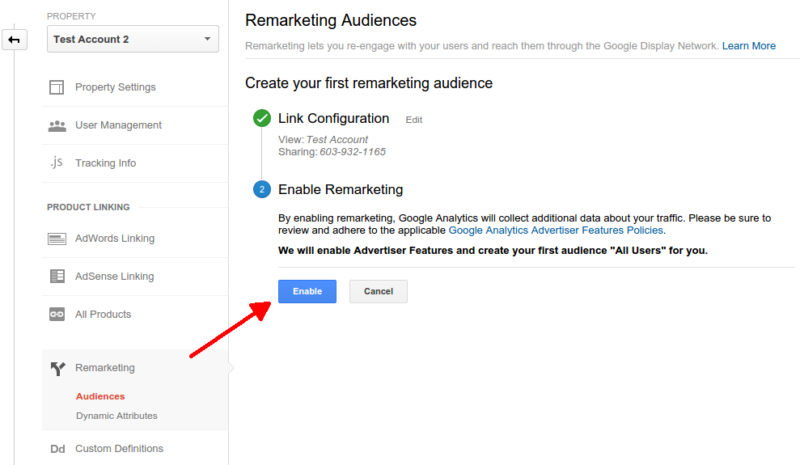Using Remarketing in Google Analytics: A Comprehensive Overview
Taking advantage of remarketing in Google Analytics uses services a calculated edge in reaching out to possible consumers. This overview will certainly lose light on the necessary steps entailed in using the full possibility of remarketing in Google Analytics, leading to improved advertising and marketing results.
Comprehending Remarketing in Google Analytics
Remarketing in Google Analytics permits organizations to purposefully target individuals that have actually formerly interacted with their website or mobile app. By leveraging information from Google Analytics, businesses can create customized remarketing listings based upon user behavior, such as pages checked out, activities taken, or specific objectives achieved. This effective device allows organizations to re-engage with customers who have actually shown rate of interest in their service or products, inevitably raising the chance of conversion.
Comprehending the different kinds of remarketing methods is important for a successful campaign - What Is “Remarketing” In Google Analytics?. Google Analytics provides different options, consisting of conventional remarketing, dynamic remarketing, and remarketing listings for search advertisements (RLSA) Each type serves a distinct purpose and can be tailored to satisfy specific advertising and marketing purposes
In addition, evaluating the efficiency of remarketing campaigns is important for maximizing outcomes. Google Analytics gives important understandings right into the performance of various remarketing approaches, enabling services to make data-driven choices and fine-tune their targeting strategy. By constantly adjusting and monitoring remarketing initiatives based upon analytics data, services can maximize ROI and drive success in their advertising initiatives.
Establishing Remarketing Campaigns

After establishing up target market listings, the next step is to connect Google Analytics with Google Advertisements. By connecting these 2 platforms, businesses can effortlessly transfer audience lists from Google Analytics to Google Ads for remarketing objectives. This integration permits for even more precise targeting and better project performance.
Once the accounts are connected, services can develop remarketing projects in Google Ads using the audience provides formerly specified in Google Analytics. These campaigns can be tailored with particular advertisement creatives, messaging, and bidding process methods to successfully re-engage with past visitors and drive conversions. By complying with these actions, companies can utilize the power of remarketing to enhance their advertising efforts and raise ROI.
Making Use Of Target Market Division Approaches

Predefined sectors in Google Analytics permit you to rapidly assess typical target market categories like brand-new customers, returning users, or users who completed a certain goal on your internet site. Personalized sections, on the other hand, allow you to create distinct segments based upon details standards that are essential to your organization goals. Dynamic remarketing listings instantly adjust based on customer actions, revealing personalized advertisements to users who have interacted with your site specifically means.
Studying Remarketing Efficiency Metrics
Upon reviewing the efficiency of remarketing campaigns in Google Analytics, the evaluation of key performance metrics gives valuable insights right into audience involvement and my blog conversion prices. By diving right into metrics such as click-through rates (CTR), conversion rates, price per acquisition (CERTIFIED PUBLIC ACCOUNTANT), and return on ad spend (ROAS), marketers can assess the success of their remarketing Our site efforts. Assessing these metrics enables marketers to optimize projects, fine-tune audience targeting, and designate budgets successfully to enhance general remarketing efficiency.
Maximizing Remarketing Strategies
When refining remarketing strategies in Google Analytics, concentrating on audience segmentation is vital for attaining project success. By dividing your audience into certain sections based on their habits, demographics, or interests, you can customize your ads more successfully to every team. This targeted technique increases the possibility of involving customers who have actually already shown passion in your solutions or products, causing greater conversion prices.
One more critical facet of enhancing remarketing approaches is continuously screening and refining your projects (What Is “Remarketing” In Google Analytics?). A/B testing different advertisement creatives, messaging, or deals look at this website can aid you recognize what resonates best with your target market and drives the most conversions. By assessing the performance of these tests in Google Analytics, you can make data-driven choices to maximize your remarketing efforts further
Moreover, leveraging dynamic remarketing can dramatically boost your campaign results. This attribute permits you to reveal tailored ads to individuals based upon their past communications with your internet site, showcasing services or products they have formerly viewed. By delivering tailored web content to customers based upon their actions and interests, vibrant remarketing can assist enhance interaction and drive conversions.
Verdict
In final thought, utilizing remarketing in Google Analytics is a calculated technique to target individuals who have formerly engaged with a site. By developing tailored target market lists and making use of audience segmentation methods, services can maximize remarketing campaigns for increased conversion prices. Examining efficiency metrics and continually enhancing approaches are critical for maximizing the efficiency of remarketing efforts.
Google Analytics supplies different alternatives, including basic remarketing, vibrant remarketing, and remarketing checklists for search advertisements (RLSA)After setting up audience lists, the following action is to connect Google Analytics with Google Advertisements. By connecting these two platforms, services can perfectly transfer audience listings from Google Analytics to Google Advertisements for remarketing objectives.When the accounts are connected, businesses can produce remarketing campaigns in Google Advertisements making use of the target market details previously defined in Google Analytics.When refining remarketing approaches in Google Analytics, concentrating on target market segmentation is paramount for achieving campaign success.